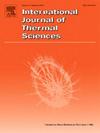3D printing of CNTs-modified continuous carbon fiber composites driven by Joule-heat resin curing
IF 5
2区 工程技术
Q1 ENGINEERING, MECHANICAL
International Journal of Thermal Sciences
Pub Date : 2025-06-04
DOI:10.1016/j.ijthermalsci.2025.110048
引用次数: 0
Abstract
Amidst the growing scarcity of energy resources, we are committed to fully exploiting the capabilities of anisotropic materials present in nature. Additive manufacturing (3D printing) has surfaced as a promising avenue for this objective, particularly with the increasing adoption of continuous carbon fiber (CF) reinforced thermosetting resins, which exhibit superior strength-to-weight ratios compared to metallic materials. However, issues such as delamination and the intricacies of real-time curing and molding processes pose significant challenges in this domain. In this research, we introduce a method for Joule heat curing (JHC)-based 3D printing. Initially, a structure mimicking “tree roots” is established by grown carbon nanotubes (CNTs) at the CF interface through the thermotropic flash assembly (TFA) technique, resulting in a 39.8 % enhancement in interfacial shear strength. Additionally, precision precisely controlled Joule heat epoxy resin is utilized for rapid curing and improved adhesion, achieving an curing degree of 0.44. Ultimately, a manipulator facilitates free-forming capabilities. This process leads to substantial increases in interlaminar shear strength while maintaining tensile strength close to its original value. By directly applying “line energy” to the material, this methodology enables efficient regulation and utilization, yielding enhanced efficiency, energy conservation, and cost reduction.
焦耳热树脂固化碳纳米管改性连续碳纤维复合材料的3D打印
在能源日益稀缺的情况下,我们致力于充分利用自然界中存在的各向异性材料的能力。增材制造(3D打印)已经成为实现这一目标的一个有前途的途径,特别是随着连续碳纤维(CF)增强热固性树脂的日益普及,与金属材料相比,它具有优越的强度重量比。然而,诸如分层和实时固化和成型过程的复杂性等问题对该领域构成了重大挑战。在本研究中,我们介绍了一种基于焦耳热固化(JHC)的3D打印方法。首先,通过热致性闪光组装(TFA)技术,在CF界面上生长碳纳米管(CNTs),形成模拟“树根”的结构,界面剪切强度提高了39.8%。此外,精密控制焦耳热环氧树脂用于快速固化和改善附着力,实现0.44的固化度。最终,机械手促进了自由成形的能力。这一过程导致层间抗剪强度大幅提高,同时抗拉强度保持在接近原始值的水平。通过直接将“线能量”应用于材料,这种方法能够有效地调节和利用,从而提高效率,节约能源,降低成本。
本文章由计算机程序翻译,如有差异,请以英文原文为准。
求助全文
约1分钟内获得全文
求助全文
来源期刊

International Journal of Thermal Sciences
工程技术-工程:机械
CiteScore
8.10
自引率
11.10%
发文量
531
审稿时长
55 days
期刊介绍:
The International Journal of Thermal Sciences is a journal devoted to the publication of fundamental studies on the physics of transfer processes in general, with an emphasis on thermal aspects and also applied research on various processes, energy systems and the environment. Articles are published in English and French, and are subject to peer review.
The fundamental subjects considered within the scope of the journal are:
* Heat and relevant mass transfer at all scales (nano, micro and macro) and in all types of material (heterogeneous, composites, biological,...) and fluid flow
* Forced, natural or mixed convection in reactive or non-reactive media
* Single or multi–phase fluid flow with or without phase change
* Near–and far–field radiative heat transfer
* Combined modes of heat transfer in complex systems (for example, plasmas, biological, geological,...)
* Multiscale modelling
The applied research topics include:
* Heat exchangers, heat pipes, cooling processes
* Transport phenomena taking place in industrial processes (chemical, food and agricultural, metallurgical, space and aeronautical, automobile industries)
* Nano–and micro–technology for energy, space, biosystems and devices
* Heat transport analysis in advanced systems
* Impact of energy–related processes on environment, and emerging energy systems
The study of thermophysical properties of materials and fluids, thermal measurement techniques, inverse methods, and the developments of experimental methods are within the scope of the International Journal of Thermal Sciences which also covers the modelling, and numerical methods applied to thermal transfer.
 求助内容:
求助内容: 应助结果提醒方式:
应助结果提醒方式:


